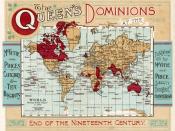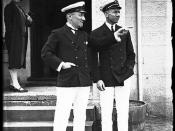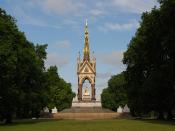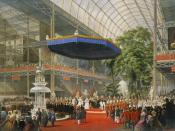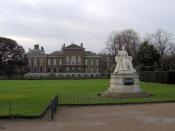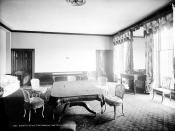Queen Victoria was one of England's most famous and beloved monarchs who created an age considered "impossible to describe...in a few sentences: it was so varied, so full of paradoxes. An age of material splendor and technical advance" (Drabble). During her sixty-four year reign, she helped "the British Empire to expand" while "the new middle class lived in luxury" (Drabble). In addition to the prosperity, her era "was also marked by unprecedented poverty, overcrowding and disease" while "British women and children" worked "long hours in appalling conditions in mines and factories" (Drabble). Today, though, she "ranks....with Elizabeth I, in public perception, as one of the country's two greatest monarchs" (Gascoigne 669).
Victoria was born at Kensington Palace on May 24, 1819. Her parents were Edward the Duke of Kent and Victoire the Duchess of Kent (previously Victoire of Saxe Coburg Saalfeld before marriage). Victoria was born during an "undignified rush to provide heirs to the throne" (Drabble 14).
This was because of the "death in childbirth of Princess Charlotte in November 1817, only daughter and heir to the prince regent" George IV (Cannon 954). Due to her death, every one of King George III's seven sons (all of whom had illegitimate children) left their wives and married women of royal blood to provide an heir to the throne. The Duke of Kent quickly left his current wife "with whom he had been....happily" married for many years and re-married to the Duchess of Kent. A year later Victoria was born. Having completed his duty, the Duke of Kent died a few months later of pneumonia.
After the death of her father, Victoria was raised in a household "almost totally female and totally German" (Cannon 954). As a little girl, she "grew up intelligent and self-possessed" (Cannon 954-5). Her daily life included pony rides and playing with her one-hundred and thirty-two dolls. By age ten, her schooling included "language exercises, lessons in court decorum, readings from moralistically bowdlerized literature, and religious education" (Weintraub 64) which she received from her governess and other tutors at Kensington Palace. In addition to her schooling, "she read widely, spoke several 2 languages, sang well and drew competently, enjoyed music and the theatre." (Cannon 955). Victoria had two sisters and one brother from her mother and father's first marriage (none of them had one hundred percent royal blood, making them ineligible as heirs to the throne). Her favorite was her half sister Fedora (from her mother's side) who she "adored" and spent most of her time with (Cannon 954).
Victoria "inherited the throne of Great Britain at the age of eighteen, upon the death of her uncle William IV in 1837" (Cody). The early years of her reign as queen were much influenced by her first prime minister, Lord Melbourne (Gascoigne 669). Under his guidance, he helped to educate her as a queen and assisted in her decision making.
In October 1839, Victoria was introduced to her cousin Prince Albert of Saxe-Coburg Gotha (from her mother's side) in hopes that they might like each other and get married. "One look" at each other "was enough" (Cannon 955) for Victoria. Three days after they met, she proposed to him and they married the next year. John Cannon of The Oxford Companion to British History described Victoria's life as having three parts: "before Albert, with Albert, and after Albert" (954). Her undying love for him made her a "model of wifely devotion" (Drabble). Soon after Albert and Victoria were married, he replaced Melbourne as her chief advisor and became the main influence in all of her decisions (Cody). Together they had many triumphs including the Great Exhibition of 1851 which was "responsible for a great deal of popularity later enjoyed by the British monarchy" (Cody). It was "housed in the Crystal Palace and was viewed by proud Victorians as a monument to their own cultural and technological achievements" (Cody).
In December of 1861, Victoria's greatest tragedy occurred when Albert died at the age of forty-two after enduring months of exhaustion and illness; this began the third and last phase of her life (Cannon 954). After "his early and sudden death" she "dressed as a widow" (Cannon 955) and traveled "abroad but once a year" making "few public 3 appearances" (Cody). Even without her beloved Albert, Victoria still had some of her greatest triumphs. The largest was her Golden Jubilee in 1887 followed ten years later by her Diamond Jubilee. Both were grand national celebrations that celebrated the fifty and sixty year anniversaries of (respectively) her reign as queen. Seven years after Albert died, she published her first book called Leaves from the Journal of our Life in the Highlands. In 1884 she released it's follow up, More Leaves.
In 1868, she appointed Benjamin Disraeli as her Prime Minister. Disraeli became a very dear friend to her because of his "commitment to British imperial interests" (Gascoigne 669). In 1876, "she succumbed to" his flattery "and permitted him....to have her crowned Empress of India" (Cody). To compensate him for his loyal service to England, she made him the Earl of Beaconsfield.
"She next found comfort in the friendship of John Brown" a servant who she took everywhere (Gascoigne 669). "As 'the Queen's Highland Servant,' Brown" took orders from her alone and obeyed her every command (Weintraub 373). She once described him as a combination of "groom, footman, page and maid, I might almost say, as he is so handy about cloaks and shawls.... He always leads my pony, and always attends me out of doors, and such a good, handy, faithful attached servant" (Weintraub 291). After the press found out about John, many thought that the two were having an affair and began calling Victoria Mrs. John Brown. The real truth was that the relationship between the two resembled a connection that "a mother and her oversized, and somewhat simple foster son" would have "rather than a noble mistress and lowborn lover" (Weintraub 375).
After John's death, she spent the rest of her life in seclusion only appearing in public for special occasions. "She died a venerable old lady....on January 22, 1901, having reigned for sixty-four years" (Cody 291). But Victoria left behind a legacy that would last forever through her children (and all of Britain). "Her nine children provided by the time of her death forty grandchildren (thirty-one still alive) and a further thirty-seven great- 4 grandchildren" (Cannon 291). After she died, the majority of them held high ranking positions somewhere in Europe including: Sweden, Norway, Spain, Greece, Romania, Bulgaria, Germany, and Russia (Cannon 956). "The tiny lady in the wheelchair was 'the matriarch of Europe' " (Cannon 291).
Margaret Drabble, author of For Queen and Country: Britain in the Victorian Age described Victoria as a person that "lived through many crises, both personal and national, so it is difficult to point out any one achievement or characteristic of her reign and say 'That is typically Victorian' " (7). Based on these achievements and the Victorian Age that she created, Victoria can be called a trend-setter. After Albert's death, "her genuine but obsessive mourning....played an important role in the evolution of what would become the Victorian mentality" (Cody). Her role as a "devoted wife" could be seen in any "loyal women seen in Victorian paintings whose main task seemed to be to support and cherish their husbands" (Cody). Victoria was also the first monarch to use the "imperial 'we' " which is commonly used today to mock the English language (Cody).
Over the years, Victoria has received positive criticism with a few exceptions. These exceptions were most evident with the critics of her time, who were responsible for many humorous writings and political cartoons mocking the forty year period that she mourned her husband's death. One modern-day critic, John Cannon, described the way "she remained to the end a mass of contradictions"à ¾oself-centered yet considerate and dutiful; homely yet grand; excitable and passionate but with shrewd judgment" (956). In the introduction to Dr. Bruce Rosen's Internet site, he mentioned a writer named Virginia Woolf who described Victoria's mind as a 'radical commonplace, only in its inherited force, & cumulative sense of power, making it remarkable" (Rosen). Based on the different opinions of Victoria, she was a woman with a complex personality. In the end though, she was a "living embodiment of a happy wife who" (Drabble 27) could not bare to live without a husband.
5 Victoria was one of England's greatest rulers and one of the most important people in history because of her many offspring. For example, "in World War I one of her grand-sons was the British king, another the German Kaiser" (Gascoigne 669). Today it is impossible to describe some form of English writing, art-work or furniture from the mid 1800's and on with-out using the word Victorian. "Many people in Britain live in Victorian houses, go to Victorian schools, use letter-boxes, railway stations, park benches that would have been familiar sites one hundred years ago" (Weintraub 8). The novelist Henry James wrote after she died, "I mourn the safe and motherly old middle-class queen, who held the nation warm under the fold of her big, hideous Scotch-plaid Shawl....I felt her death more than I should have expected" (Cannon 956).
6 Famous Lines "I will be good""à ¾oHer response when she was told (at age twelve) she was heir to the throne "I am very young and perhaps in many, though not in all things, inexperienced, but I am sure, that very few have more real good will and more real desire to do what is fit and right than I have.""à ¾oExerpt from a passage in her diary, 1837 "Albert's beauty is most striking, and he is so amiable and unaffected-in short, very fascinating....""à ¾oExerpt from a note she wrote to King Leopold the day she proposed to Albert "We did not sleep much""à ¾oExerpt from her journal describing her wedding night 7 WORKS CITED Cannon, John, ed. The Oxford Companion to British History. New York: Oxford University Press, 1997 Cody, David. "Queen Victoria." http://www.btg.brown.edu/projects/hypertext/landow/ victorian/un/victor6.html (21 Feb. 1999) Drabble, Margaret. For Queen and Country: Britain in the Victorian Age. New York: The Seabury Press, 1978 Gascoigne, Bamber, ed. Encyclopedia of Britain. New York: Macmillan Publishing Company, 1993.
Rosen, Bruce. "Queen Victoria's World." Introduction. http://www.box.net.au/~brosen/ quframe.htm (21 Feb. 1999) Weintraub, Stanley. Victoria: An Intimate Biography. New York: Truman Talley Books, 1987
